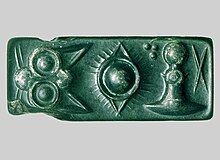
Minoan seals are impression seals in the form of carved gemstones and similar pieces in metal, ivory and other materials produced in the Minoan civilization. They are an important part of Minoan art, and have been found in quantity at specific sites, for example in Knossos, Mallia and Phaistos. They were evidently used as a means of identifying documents and objects.
Minoan seals are of a small size, 'pocket-size', in the manner of a personal amulet. Many of the images are a similar size to a human fingernail, with a high proportion that of the nail of a little finger. They might be thought of as equivalent to the pocket-sized, 1 inch (3 cm) scaraboid seals of Ancient Egypt, which were sometimes imitated in Crete.[1] However Minoan seals can be larger, with largest examples of many inches.
Minoan seals are the most common surviving type of Minoan art after pottery, with several thousand known, from EM II onwards, in addition to over a thousand impressions, few of which match surviving seals.[2] Cylinder seals are common in early periods, much less so later. Seals with different shapes and multiple faces are especially common, unusually so by comparison with later and neighbouring cultures: "lentoid" ones have two faces, usually curving towards a thin circular edge, and there are many "prism" ones with three flat faces.[3] A seal-carving workshop from MM I excavated at Malia mostly made this type; here, as throughout the surviving seals, there are wide variations in the quality of the carving.[4] Often seals are pierced, so they can be worn around the neck or wrist on a string. Probably many early examples were in wood, and have not survived. Ivory and soft stone were the main surviving materials for early seals, the body of which were quite often formed as animals or birds.[5] From the Middle Minoan period fast rotary drills were used, enabling harder stones to be utilized.[6]

Later, some are extremely fine engraved gems; other seals are in gold, usually on signet rings.[7] The subjects shown cover the full range of Minoan art. The so-called Theseus Ring was found in Athens; it is gold, with a bull-leaping scene in intaglio on the flat bezel.[8] The Pylos Combat Agate is an exceptionally fine engraved gem, probably made in the Late Minoan, but found in a Mycenaean context.[9] This is a common issue: Minoan art was exported around the Aegean sea and beyond, and many finds in Mycenaean and other contexts are thought to be either made in Crete or by Cretan or Cretan-trained artists working outside Crete.
© MMXXIII Rich X Search. We shall prevail. All rights reserved. Rich X Search
